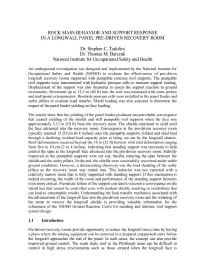Mining Publication: Rock Mass Behavior and Support Response in a Longwall Panel Pre-Driven Recovery Room
Original creation date: March 2008
Authors: SC Tadolini, TM Barczak
NIOSHTIC2 Number: 20033693
Proceedings of the 6th International Symposium on Ground Support in Mining and Civil Engineering Construction, Cape Town, Republic of South Africa, March 30-April 3, 2008. Johannesburg, Republic of South Africa: The South African Institute of Mining and Metallurgy, 2008; :167-182
An underground investigation was designed and implemented by the National Institute for Occupational Safety and Health (NIOSH) to evaluate the effectiveness of pre-driven longwall recovery rooms supported with pumpable concrete roof supports. The pumpable roof supports were instrumented with hydraulic pressure cells to measure support loading. Displacement of the support was also measured to assess the support reaction to ground movements. Movement up to 12.5 m (40 ft) into the roof was measured with sonic probes and multipoint extensometers. Borehole pressure cells were installed in the panel fender and outby pillars to evaluate load transfer. Shield loading was also assessed to determine the impact of the panel fender yielding on face loading. The results show that the yielding of the panel fender produced uncontrollable convergence that caused yielding of the shields and stiff pumpable roof supports when the face was approximately 3.12 m (10 ft) from the recovery room. The shields continued to yield until the face advanced into the recovery room. Convergence in the pre-driven recovery room typically reached 15-20 cm (6-8 inches) once the pumpable supports yielded and shed load through a declining residual load capacity prior to being cut out by the longwall shearer. Roof deformations occurred beyond the 10 m (32 ft) horizon with total deformation ranging from five to 10 cm (2 to 4 inches), indicating that standing support was necessary to help control the span as the longwall face advanced into the pre-driven recovery room. Stability improved as the pumpable supports were cut out, thereby reducing the span between the shields and the outby pillars. In the end, the shields were successfully recovered under stable ground conditions. However, a disconcerting discovery was the load shedding of the outby pillars as the recovery room was mined into. This behavior was not expected with a relatively narrow room that is fully supported with standing support. If this mechanism is indeed occurring, the width of the room and performance of the standing support becomes even more critical. Premature failure of the support can lead to excessive convergence on the shield line that cannot be controlled even with modern shields, resulting in instabilities that can lead to catastrophic results. Understanding the load transfer mechanics associated with the advancement of the longwall face into the pre-driven recovery room and the widening of the room to recover the longwall shields is providing valuable information for the refinement of the NIOSH Ground Reaction Curve for standing and intrinsic roof support system design.

NIOSHTIC2 Number: 20033693
Proceedings of the 6th International Symposium on Ground Support in Mining and Civil Engineering Construction, Cape Town, Republic of South Africa, March 30-April 3, 2008. Johannesburg, Republic of South Africa: The South African Institute of Mining and Metallurgy, 2008; :167-182
- Development and Application of the Coal Mine Roof Rating (CMRR)
- Diagnosing and Controlling Moisture-Sensitive Roof in Coal Mines
- Evaluation of Support and Ground Response as Longwall Face Advances into and Widens Pre-Driven Recovery Room
- Guidelines for the Control and Monitoring of Methane Gas on Continuous Mining Operations
- The Introduction of Roof Bolting to U.S. Underground Coal Mines (1948-1960): A Cautionary Tale
- Numerical Modeling for Increased Understanding of the Behavior and Performance of Coal Mine Stoppings
- Performance Characteristics for Welded Wire Screen Used for Surface Control in Underground Coal Mines
- Prediction of Longwall Methane Emissions and the Associated Consequences of Increasing Longwall Face Lengths: A Case Study in the Pittsburgh Coalbed
- Pumpable Roof Supports: Developing Design Criteria by Measurement of the Ground Reaction Curve
- Use of Surface Joint and Photolinear Data for Predicting Subsurface Coal Cleat Orientation